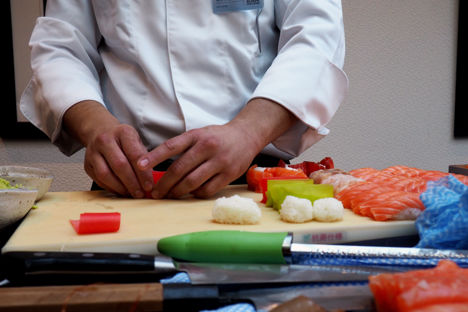
Making the grade: the UK’s greatest sushi chefs
One of London’s legendary Japanese fine dining establishments, Nobu, played host to the UK round of the Global Sushi Challenge. Tested on speed, technique, flair and creative skill, the competing chefs worked with quality ingredients to produce stunning sushi plates.
Making the grade: the UK’s greatest sushi chefs
One of London’s legendary Japanese fine dining establishments, Nobu, played host to the UK round of the Global Sushi Challenge. Tested on speed, technique, flair and creative skill, the competing chefs worked with quality ingredients to produce stunning sushi plates.
The UK is one of fourteen countries taking part in the Global Sushi Challenge, which held its heats in Nobu, London. Nine chefs in total took part, and with their day jobs ranging from executive sushi makers to self-taught gastropub chefs the competition promised an interesting – and refreshingly diverse – mix of perspectives.
The first round was an Edomae sushi speed test. A style of sushi dating back to the Edo period in the early eighteenth century, this is what many of us today – including those great minds behind smartphone emojis – would regard to be ‘classic sushi’. Replacing traditional preparation methods of salted, preserved fish with raw fish and rice, Edomae sushi was made with the intention of being eaten quickly – Japanese fast food.
Fast certainly seemed the operative word as the judges outlined the rules of the round, with contestants expected to prepare two plates containing seven pieces of nigiri-style sushi (including salmon, shellfish and egg) alongside six pieces of cucumber maki in just ten minutes. After a rigorous inspection of each chef’s area – the judges were awarding points for cleanliness and method as well as technique – they were off, deftly slicing fat slabs of glorious, plump fish and shaping rice with idiosyncratic flourishes.
Observing the preparation was incredibly interesting, and the knife skills on display were staggering. Watching the chefs pile up neat, identical slices of succulent salmon, I wondered why I never ventured further than smoked salmon in the sushi I make at home. What is there to be afraid of? It reminded me of a lengthy debate I’d come across online the last time my sushi courage failed me: is there such a thing as ‘sushi grade’ fish, or is this a term invented by supermarkets to up the price? When I put this to an expert from Norwegian Seafood her answer was, mercifully, a lot shorter than that on the internet: ‘The term ‘sushi grade’ is an indicator of safety rather than quality. To eat raw fish you need to be sure it’s not carrying any dangerous bacteria; wild seafood will need be frozen first, while farmed fish is safe to eat fresh.’
In what felt like no time at all – I’d barely had the chance to ambush the waiters circling with California rolls more than two or three times – the chefs were told to step back from their stations. Of the five chefs competing only two had managed to come near to completing the task, with the other three disqualified from the round. No doubt rubbing salt in their wounds a little, one of the judges pointed out that it was expected of sushi chefs in Japan to achieve this in half the time.
The next challenge was something rather exciting: creative sushi. Unlike the Edomae sushi round, which was a test of their speed and accuracy, the emphasis here was on imagination and skill with a full hour to complete the challenge.
The creative sushi round allowed chefs to bring their own ingredients, allowing a fascinating insight into just how personal the practice of sushi making really is. Some chefs produced stacks of tiny boxes filled with powders and pastes, some had flavoured their mayonnaise with yuzu and ginger and one chef was using sheets of colourful soybean paste in place of traditional nori. ‘It’s becoming very popular,’ explained his colleague, watching nervously in the audience. ‘We’ve found that many people like sushi but aren’t as keen on the taste of seaweed. This provides an alternative that looks great too!’
Particularly striking was the work of Tai Po Wong, executive sushi chef of Sushisamba, London. While many of the other competitors opted for a more classic presentation style, Tai Po’s contemporary plating felt more reminiscent of the modern European style made famous by such chefs as Massimo Bottura, with vibrant splatters, bold colours and the full expanse of plate used.
This, to me, represents precisely what Japanese culture is all about. My experience of Japan, albeit brief, demonstrated that it is in many ways a paradoxical culture, both rooted in tradition and relentlessly modern innovations. It’s a place where high speed trains whizz past thousand year old temples, with ramen shops and robot restaurants on the same street. To see these chefs blending traditional techniques with contemporary sensibilities and style was exciting and inspirational; this was performance art, scientific display and culinary wizardry all in one go.
The winner of the UK competition was Xia Jia Tian from Kouzu, London. The final will take place in Tokyo, Japan in November where an overall winner will be crowned sushi champion.


